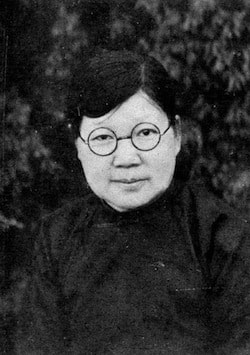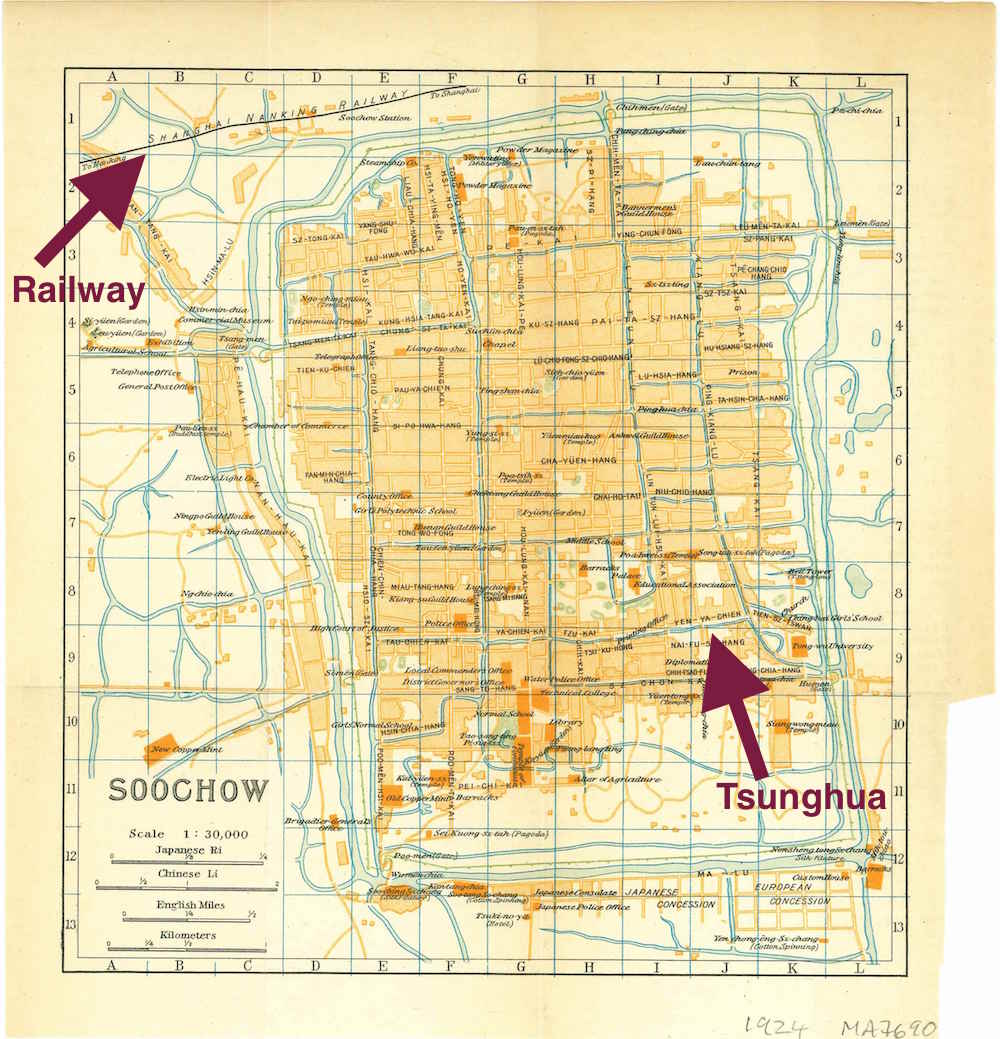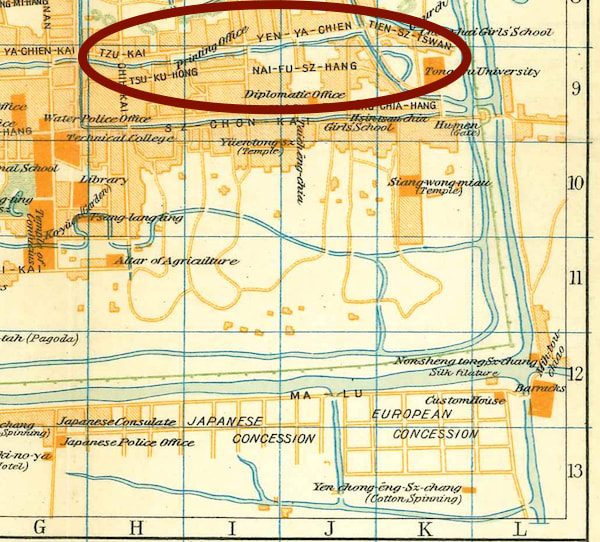Tsunghua Girls’ School
c. 1920-1926
"Tsinghua in the North, Tsunghua in the South", "the most Chinese of schools" – these are some of the phrases that have been used to describe the reputation and standing of the school in Suzhou which Zing Wei was fortunate enough to attend. Is it possible, that on some level, Zing Wei's girls' school warranted comparison with Han Liang's vaunted tertiary institution? The second epithet suggests that pride lay not only in the quality of the education, but specifically in the fact that it was achieved without foreign backing. Han Liang's former Columbia classmate, educator Tao Xingzhi, apparently commented at some point: "Tsunghua is one of the very best schools – it was a pioneer in the area of women's education."
That Zing Wei attended the school we know by her own account. But for how long, whether she went before or after her parents’ deaths, or how she could have met the tuition as an orphan remain mysteries. The school’s records are patchy for the years before 1928 when it moved to its present-day site and by which time Zing Wei would have left. Yet it is beyond doubt that somewhere along the line Zing Wei received a solid education: she would in future often serve as her husband’s secretary and scribe, and her surviving letters attest to a fluent calligraphic hand and polished turn of phrase.
That Zing Wei attended the school we know by her own account. But for how long, whether she went before or after her parents’ deaths, or how she could have met the tuition as an orphan remain mysteries. The school’s records are patchy for the years before 1928 when it moved to its present-day site and by which time Zing Wei would have left. Yet it is beyond doubt that somewhere along the line Zing Wei received a solid education: she would in future often serve as her husband’s secretary and scribe, and her surviving letters attest to a fluent calligraphic hand and polished turn of phrase.
 Zing Wei had most likely graduated a couple years before this 1928 photo, titled: “Student Body of Suzhou Tsunghua Girls’ School, Primary and Secondary Sections, Photographed in November of the 17th Year of the Republic, New Campus, Next to the West Garden’s Rui Yun Feng Rockery”.
Zing Wei had most likely graduated a couple years before this 1928 photo, titled: “Student Body of Suzhou Tsunghua Girls’ School, Primary and Secondary Sections, Photographed in November of the 17th Year of the Republic, New Campus, Next to the West Garden’s Rui Yun Feng Rockery”.
|
Tsunghua (振華女學校 Zhenhua Nü Xuexiao) was founded in 1906, two years before Zing Wei was born and five years before Peking's Tsinghua College. The woman who founded Tsunghua – Wang Xie Changda (王謝長達) – was a privileged member of the gentry elite who also started and led a society to abolish foot-binding, as well as other organizations concerned with the welfare of women and national reform. Indeed, the name of Wang’s school means “Reinvigorate China”.
While Wang’s activities may cast her as an early feminist, the education of women was a popular cause at the time, viewed by at least as many men as women as essential to China’s overall reform and modernization – in short, the betterment of women was a patriotic rallying point. In the year of Tsunghua’s founding, the Empress Dowager also issued an edict calling for the establishment of girls’ schools. |
Critical to the school’s prestige was educator, sometime government official, and early supporter of the Kuomintang Ts’ai Yüan-p’ei (蔡元培 Cai Yuanpei, 1868-1940). Prior to Tsunghua, Ts'ai had been involved in the founding of the “Patriotic School for Girls” in Shanghai. By the time Zing Wei attended Tsunghua, he was chancellor of Peking University.
Before becoming radicalized, Ts’ai had achieved the highest rank of “jinshi” (進士) in the old examination system and joined the rarefied Hanlin Academy, to which Zing Wei's great-grandfather claimed a link. It was there that Ts'ai became a beloved pupil of Wang’s husband, a scholar in the Qing court, and it was through this connection that he agreed to become a trustee of Tsunghua. Even more importantly, Ts'ai became a regular lecturer at Tsunghua attracting many of the best minds of the day to do likewise.
Before becoming radicalized, Ts’ai had achieved the highest rank of “jinshi” (進士) in the old examination system and joined the rarefied Hanlin Academy, to which Zing Wei's great-grandfather claimed a link. It was there that Ts'ai became a beloved pupil of Wang’s husband, a scholar in the Qing court, and it was through this connection that he agreed to become a trustee of Tsunghua. Even more importantly, Ts'ai became a regular lecturer at Tsunghua attracting many of the best minds of the day to do likewise.
|
Equally instrumental to Tsunghua’s success was Chi-nyok Wang (王季玉 Wang Jiyu, 1885-1967), the third of Wang’s five daughters. She had partaken of all the opportunities for modern education available before schools such as Tsunghua got underway. Educated first at a mission school in Suzhou, she went on to study in Japan, train as a botanist at Mt. Holyoke and the University of Illinois, and also attend Columbia Teachers’ College and the University of Chicago.
After returning from the US, the younger Wang joined her mother’s school and established its secondary section in 1918. Presumably she would have been in charge when Zing Wei attended. In 1926 – roughly the time that Zing Wei would have left the school, Wang became Tsunghua's overall principal, energetically serving until 1958 and declining many offers to head other notable schools. |
The Tsunghua faculty also included Wang’s sisters Wang Jizhao (王季昭), a Tsinghua and Pomona graduate, and Wang Jichang (王季常), a Tsinghua graduate. Their nieces, Ho I-Djen (何怡貞 He Yizhen) and He Zehui (何澤慧), daughters of another scholarly sister, Wang Jishan (王季山), were both among Tsunghua’s first graduates and went on to become accomplished physicists. Other distinguished alumnae would include playwright Yang Jiang (楊絳), who would head a Shanghai branch of Tsunghua during the war years, and Lu Cui, who would be a student leader at Tsinghua in the 1930s. Fei Hsiao-Tung (費孝通 Fei Xiaotong), father of the fields of sociology and anthropology in China and a seminal influence on Zing Wei’s eventual youngest child Philip, was one of several male students who attended Tsunghua.
Relatively speaking, if Lake Tai were a clock, Wuxi and Suzhou would be located at 12 and 3 o'clock, respectively. As the crow flies, from Zing Wei's village, the distance was about 50 miles. By the early 1920s, it's probable that Zing Wei would have made most of the trip by rail, with perhaps the last three miles from the rail station by boat along Suzhou's canals. The train station was outside the city walls on the north side (D1 on map below), while Tsunghua was within the city walls in its southeast corner, along a canal called Yen Ya Chien (嚴衙前 Yan Ya Qian; J8 on map below). One assumes that whether or not she attended with any of her cousins, detailed arrangements were made for her initial trip, as well as for return trips to her uncle's home at least once a year at Chinese New Year.
|
We can be fairly confident that her baggage included several changes of wide-sleeved white blouses and pleated black skirts, which by then was standard attire for forward-looking young women of the post-1911, early Republican period. Like their new horizons, their feet would have been unbound.
If Zing Wei and her classmates were given at least some freedom to explore Suzhou's lanes and byways, they would likely have crossed paths with young women from the city's other, fairly numerous girls' schools. After all, the best families of the relatively prosperous Jiangnan region (江南, lit. "South of the [Yangzi] River) had often educated their daughters well, relative to the general population of Chinese women. And if Suzhou vied with nearby Hangzhou for the reputation of Jiangnan's most cultured city, much of that reputation was built on the fame of its women who were said to be not only beautiful, but also literate and refined. |
Dependent on extended relations with limited resources, Zing Wei's situation was hardly enviable, but there is some relief in knowing that the school to which she was sent was not a cruel death trap like that experienced by the fictional Jane Eyre or her real-life creator. In 1928, the school moved to its current, extensive site which formerly housed the Suzhou imperial looms. The school lives on as Suzhou No. 10 High School (江蘇省蘇州第十中學).
|
Banner caption: Believed to be the school’s main gate at its original site on Yen Ya Chien
|
|
|
TSUNGHUA'S LOCATIONS
In the map detail, the words “NAI-FU-SZ-HANG” (內?府?絲行 nei fu si hang) indicate the large government-sponsored loom compound to which the school moved in 1928 and where it remains today. It apparently still occupies most of the area labeled “Diplomatic Office". Above “NAI-FU-SZ-HANG” may be seen the words “YEN-YA-CHIEN”. One source gives this as the school’s address, so possibly this was the original location of the school during Zing Wei’s time – although it also might be just another way to refer to the nearby and later NAI-FU-SZ-HANG site. To the right of “YEN-YA-CHIEN” is “TIEN-SZ-TSWAN” (天賜莊 Tian Ci Zhuang) and to the left is “TZU-KAI” (梓街 Zi Jie, lit. "Catalpa Street"). Nowadays all three stretches of canal/street have been merged into one street called "Ten Catalpas" (十梓街). According to the Suzhou No. 10 High School website the government looms doubled as a residence for visiting emperors. Kangxi and Qianlong are alleged to have each stayed there six times. The grounds still incorporate noteworthy cultural relics, such as a famous rockery referenced in the panorama near the top of this page. |
|
SOURCES
|
|





